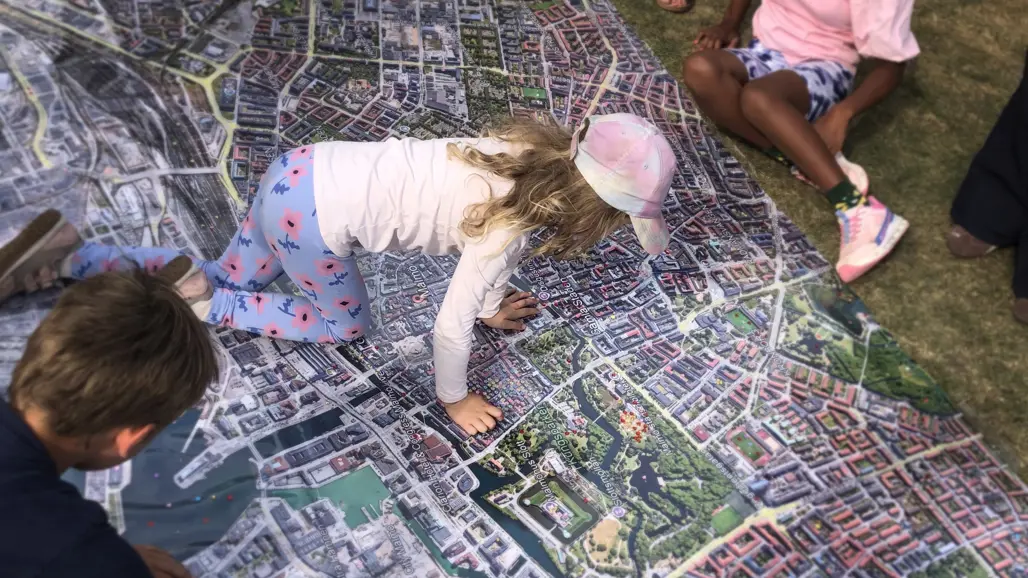
The children’s city – where play meets urban development and nature
How do children see the city? At the Malmö Festival, SLU Urban Futures and Botildenborg invited visitors on a playful journey into the world of urban development. By planting, creating, and interacting with a map, the children left their mark on Malmö—both literally and symbolically.
The Convention on the Rights of the Child has been Swedish law since 2020, and Article 12 establishes children's right to be heard in matters that concern them. But how this right is implemented in practice is another matter. It only becomes meaningful when children know their city, can identify places that are important to them, and dare to express their ideas.
The children were asked to mark their favorite places in Malmö on a satellite map. The activity was a way to:
- Help children understand their surroundings and the value of public spaces
- Link everyday experiences to the more abstract aspects of urban planning
- Give researchers and planners insight into which places children appreciate
- Strengthen children's sense of participation and belonging in the city.
"The exercise provides important knowledge about how children understand, experience, and relate to the city's spatial structures. For many children, maps are not an obvious way to show how they view their surroundings. Through the conversations that arise during the exercise, it becomes clear that their way of understanding place is often linked to the body, to experiences in the moment, and to how they move - rather than to something that can only be shown on a map," says Amanda Gabriel, hub coordinator at SLU Urban Futures, assistant professor of environmental psychology, and course leader for the course Outdoor environments for children and youth.
“Therefore, the activity becomes not only a way to identify which places are perceived as significant, but also a process that highlights differences in spatial understanding and access to representation tools. The exercise helps both researchers and urban planners to better see the world from a child's perspective - which often differs from the way adults think when it comes to planning and urban development."
What children prefer – from theme parks to shopping malls
The places chosen by children reflect a wide variety of environments:
- Classic places such as Folkets Park, Ribersborg Beach, horse paddocks, and sports arenas were often mentioned, showing that older and well-known environments still have a strong appeal.
- Theme parks – where the design and variety of play equipment seem particularly important
- Indoor play areas in shopping malls – often commercial and subject to a fee
- Malmöfestivalen's 'Barnlandet' – shows that children often relate to places in the present and in their immediate vicinity, something that has long been supported by research.
The dialogue with the children pointed out that their urban life is characterized by places of different character – public and commercial, in green outdoor environments and in hardened indoor environments.
When nature feels foreign
In addition to marking their favorite places on a map, the children had the opportunity to plant herbs and make seed bombs. This was met with mixed reactions.
"An important insight was children's often limited and sometimes ambivalent relationship with nature and its materials. Some children described contact with mud and soil as disgusting or messy, while others had no previous experience of touching such materials. Once the children were allowed to plant and play with soil, we observed that several changed their attitude - from discomfort to curiosity and joy," says Amanda Gabriel, continuing:
"This touches on a phenomenon known in research as biophobia - a feeling of distance or even aversion to contact with nature. Studies show that this can develop in interaction between the degree of contact with nature, innate biological characteristics, cultural perceptions, and individual experiences. In particular, a lack of positive experiences of nature during childhood has been identified as a risk factor for later developing negative feelings towards nature."
One way to inspire children to play with nature and its materials is through so-called 'lekotop'. Lekotop's are multifunctional green spaces where biodiversity and ecosystem services meet children's play. Such environments combine shade, stormwater management, biodiversity, and creative play areas - and benefit both children's development and urban sustainability.
SLU's research on children's place in cities
At SLU, research on children's relationship to places, nature, and landscapes has been ongoing for several decades. Among other things, the studies have shown how children's everyday environments – courtyards, parks, schoolyards, and playgrounds - affect their health, development, and sense of participation.
This year, we further strengthened our focus on children's place in urban planning by introducing the Forum for Children and Landscapes – a platform at SLU where researchers, practitioners, and decision-makers meet to strengthen children's perspectives in planning and management. The forum serves both as a research arena and as a bridge to society, where we share knowledge, organize seminars, and collaborate with municipalities, authorities, and civil society.
SLU's participation in the Malmö Festival is part of a long-term research work aimed at permanently integrating children's perspectives into urban planning.
“Children's experiences contribute to creating more inclusive, vibrant, and equitable urban spaces. When we weave their perspectives into our work, we build better cities not only for children, but for everyone,” concludes Amanda Gabriel.
Contact
-
PersonAmanda Gabriel, LecturerDepartment of People and Society
-
SLU Urban Futures
SLU Alnarp
SLU Urban Futures
Enheten för samverkan och utveckling
Box 190
234 22 Lomma